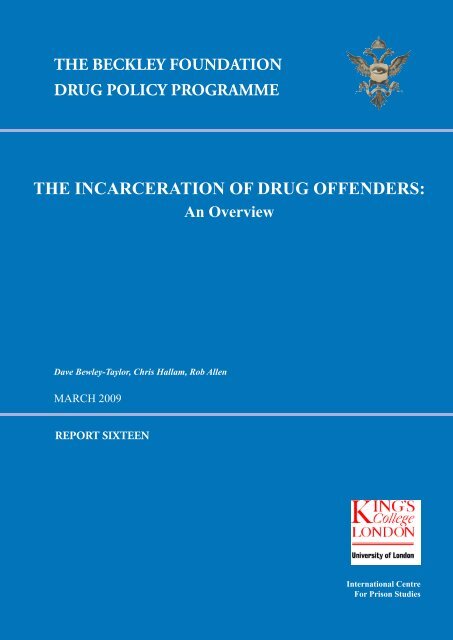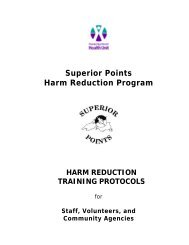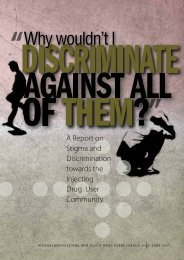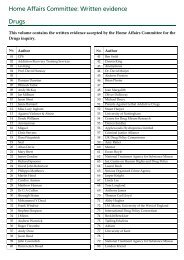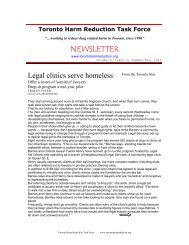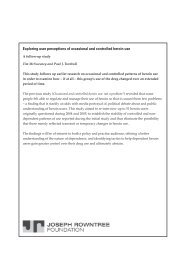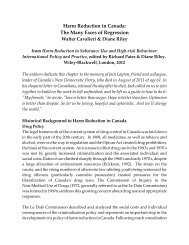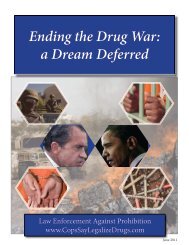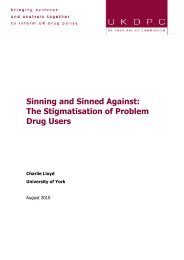The Incarceration of Drug Offenders - The Beckley Foundation
The Incarceration of Drug Offenders - The Beckley Foundation
The Incarceration of Drug Offenders - The Beckley Foundation
- No tags were found...
You also want an ePaper? Increase the reach of your titles
YUMPU automatically turns print PDFs into web optimized ePapers that Google loves.
Report 161THE INCARCERATION OF DRUG OFFENDERS:An OverviewDave Bewley-Taylor, Chris Hallam, Rob Allen 1<strong>The</strong> <strong>Beckley</strong> <strong>Foundation</strong> <strong>Drug</strong> Policy Programme (BFDPP) is an initiative dedicated to providing a rigorous, independent review<strong>of</strong> the effectiveness <strong>of</strong> national and international drug policies. <strong>The</strong> aim <strong>of</strong> this programme <strong>of</strong> research and analysis is to assembleand disseminate material that supports the rational consideration <strong>of</strong> complex drug policy issues, and leads to a more effectivemanagement <strong>of</strong> the widespread use <strong>of</strong> psychoactive substances in the future. <strong>The</strong> BFDPP currently chairs the International<strong>Drug</strong> Policy Consortium (www.idpc.info), a global network <strong>of</strong> NGOs and pr<strong>of</strong>essional networks who work together to promoteobjective debate around national and international drug policies, and provide advice and support to governments in the searchfor effective policies and programmes.SUMMARYIn 2005, the <strong>Beckley</strong> <strong>Foundation</strong> <strong>Drug</strong> Policy Programme (BFDPP)published <strong>Incarceration</strong> <strong>of</strong> drug <strong>of</strong>fenders: costs and impacts. In thisbriefing paper, we argued that most governments make strong statementsabout the need to maintain, and <strong>of</strong>ten increase, police activity andpenal sanctions for drug users. This approach, it was claimed, is basedon the idea that strong enforcement, and widespread incarceration,will deter potential users and dealers from becoming involved in theillegal drug market. Now as then, relatively few countries actuallyfollow through on such rhetoric – arrest and incarceration rates fordrug users are comparatively low in many countries in relation to thetotal number <strong>of</strong> users, and the <strong>of</strong>ten quoted maximum sentences arerarely, if ever, used. Nonetheless, penal institutions around the worldare becoming increasingly populated by drug <strong>of</strong>fenders. <strong>The</strong> fact thatthis has had only a marginal and/or temporary impact upon the scale<strong>of</strong> the illicit drug market, and also generates many significant financialand collateral costs, has led increasing numbers <strong>of</strong> observers to regardthe situation as constituting a global prison crisis. In its 2007 AnnualReport the International Narcotics Control Board felt it necessary todevote a chapter to “<strong>The</strong> Principle <strong>of</strong> proportionality and drug-related<strong>of</strong>fences.” Among other things, the Board concluded that governmentsshould consider widening the range <strong>of</strong> non-custodial options for drugrelated <strong>of</strong>fences by illicit drug users. While this intervention from theBoard is most welcome, it should be recalled that the recommendationwas made within an international legal framework where a penalapproach is strongly encouraged, particularly by the 1988 Conventionagainst Illicit Traffic in Narcotic <strong>Drug</strong>s and Psychotropic Substances.<strong>The</strong> UN drug control system remains ambivalent in its attitude topunitive measures for drugs <strong>of</strong>fences, and continues to invest rhetoricalresources in viewing the issue primarily in terms <strong>of</strong> crime ratherthan public health. In this year when the High Level Segment to theCommission on Narcotic <strong>Drug</strong>s will set the course <strong>of</strong> internationaldrug policy for at least the next decade, the BFDPP, in partnership withthe International Centre for Prison Studies at Kings College London,revisits the topic <strong>of</strong> the incarceration <strong>of</strong> drug <strong>of</strong>fenders. Here weprovide an overview <strong>of</strong> some <strong>of</strong> the available incarceration data fromaround the world and bring together much contemporary research onthe topic. A great deal <strong>of</strong> the discussion concerns one <strong>of</strong> the mostenthusiastic supporters <strong>of</strong> incarceration as a drug prevention measure.However, we suggest that the results <strong>of</strong> policy within the United Statesshould be used as evidence to encourage other member states not t<strong>of</strong>ollow this route, and we call for an adjustment <strong>of</strong> the UN system tomake it easier for them to find other ways <strong>of</strong> managing the problem.INTRODUCTIONIn attempting to reduce the availability <strong>of</strong> illicit drugs and the levels<strong>of</strong> use <strong>of</strong> such drugs, some governments have chosen to pursue lawenforcement oriented domestic drug control policies that rely heavilyupon incarceration. Such a policy choice is influenced by the desireto incapacitate, provide an element <strong>of</strong> retribution to and sometimesattempt to rehabilitate <strong>of</strong>fenders. It is also largely underpinned bythe concept <strong>of</strong> deterrence. Consequently, irrespective <strong>of</strong> its other1 Dave Bewley-Taylor is a Senior Lecturer, School <strong>of</strong> Humanities, Swansea University, UK , associateconsultant <strong>Beckley</strong> <strong>Foundation</strong> <strong>Drug</strong> Policy Programme. Chris Hallam is an International <strong>Drug</strong> PolicyConsortium Consultant. Rob Allen is the Director <strong>of</strong> the International Centre for Prison Studies (ICPS)at Kings College London http://www.kcl.ac.uk/schools/law/research/icps
3their place within US domestic policies. Indeed, the US Governmentspends more on drug prevention and treatment than any other country.Furthermore, recent years have seen an expansion <strong>of</strong> the drug courtmovement in which judges oversee the treatment <strong>of</strong> drug dependent<strong>of</strong>fenders in community based or residential settings as an alternative toshort periods <strong>of</strong> imprisonment. Nonetheless, it is the vigorous pursuit<strong>of</strong> law enforcement and criminal justice measures that remain dominant.At both the federal and state levels the US domestic “war on drugs” hasincreasingly relied upon incarceration as a deterrent.Indeed, in 2000 a Human Rights Watch report concluded that drugcontrol policies bore “primary responsibility for the quadrupling <strong>of</strong> the[US] national prison population since 1980 and a soaring incarcerationrate, the highest among western democracies…” (Human Rights Watch,2000). In that same year, nearly one in four persons imprisoned in theUS was imprisoned for a drug <strong>of</strong>fence, with a significant proportion<strong>of</strong> these individuals being non-violent <strong>of</strong>fenders (Schiraldi, Holman& Beatty, 2000). In 2000, the number <strong>of</strong> persons behind bars fordrug <strong>of</strong>fences was roughly the same as the entire US prison and jailpopulation only twenty years earlier. For comparative purposes, it isnoteworthy that at the beginning <strong>of</strong> the Twenty-First century, therewere 100,000 more persons imprisoned in the US for drug <strong>of</strong>fencesthan the total number <strong>of</strong> prisoners in the EU, even though the EUhad 100 million more citizens than the US (Schiraldi, Holman &Beatty, 2000). Today, almost half a million dealers and users are underincarceration in the US (Caulkins & Reuter, 2006).<strong>The</strong>re is an extensive body <strong>of</strong> evidence to show that the costs <strong>of</strong> suchdrug laws do not fall equally across all segments <strong>of</strong> US society. Between1985 and 1995, for instance, there was an increase <strong>of</strong> 200 percent inthe number <strong>of</strong> females incarcerated in state and federal institutions,most for non-violent <strong>of</strong>fences. Many commentators agree that much<strong>of</strong> this was the result <strong>of</strong> stricter enforcement, increased penalties andmandatory prison sentences for drug <strong>of</strong>fenders (Reichel 2005, Bush-Baskette, 1999, Gray, 2001). Additionally, while punitive US drugpolicies can be seen to have significantly affected the imprisonment <strong>of</strong>women in general, the greatest increase in the percentage <strong>of</strong> inmatesincarcerated for drug <strong>of</strong>fences is seen in African American women(Bush-Baskette, 1999).Figures concerning African-American women reflect the more generalfinding that it is predominantly minorities arrested for drug selling. Byway <strong>of</strong> example, the year-end figures for 2005 demonstrate that <strong>of</strong> the253,300 state prisoners serving sentences for drug <strong>of</strong>fences, 113,500were black, 51,100 were Hispanic and 72,300 were white. In percentageterms, the figures are, respectively, 44.8%, 20.2% and 28.5%. (Sabol etal, 2008) <strong>The</strong>se may be contrasted with the ethnic make-up <strong>of</strong> the USpopulation in general, which, according to the CIA World Fact Book, is,by percentage: black 12.85%, Hispanic approximately 15.1% and white79.96%. (CIA World Fact Book 2009) According to US governmentstatistics in 1990, African-Americans constituted only 15-20% <strong>of</strong> thenation’s drug users, but in most urban areas constituted half to two-thirds<strong>of</strong> those arrested for drug <strong>of</strong>fences (Duster, 1997). This relationship is alsoreflected with reference to marijuana in particular. African-Americansrepresent 14% <strong>of</strong> marijuana users in the general population, but 30%<strong>of</strong> arrests (King & Mauer, 2005). A similar disproportion can also beseen in the composition <strong>of</strong> prison sentence statistics (Boyum & Reuter,2005). In certain specific American states, the disparities can be muchgreater. New Jersey leads the US in terms <strong>of</strong> its record <strong>of</strong> imprisoningnon-violent drug <strong>of</strong>fenders. Nearly half <strong>of</strong> those entering the system in2003 (the last year for which detailed data exist) were drug law violators,whereas the national average is 31%. Some 62% <strong>of</strong> incoming prisonersin New Jersey are African American, while for drug law <strong>of</strong>fenders thefigure is almost three-quarters (70%). To put these figures into context,African Americans make up about 13% <strong>of</strong> New Jersey’s population(Kleykamp, M., Rosenfield J.& Scotti R., 2008). A similar pattern isrepeated in New York City. <strong>The</strong> trend toward a law enforcement focuson cannabis is striking, with 353,000 people arrested for possession <strong>of</strong>small amounts <strong>of</strong> the drug between 1997 and 2006. Of these arrests,52% were black, who make up about 26% <strong>of</strong> the city’s population; 31%were Hispanic (from 27% <strong>of</strong> the population) and 15% were white (35%<strong>of</strong> the population) (Levine & Small, 2008).It is important to note that within these figures young African-American males are a dominant group. According to the US basedSentencing Project, nearly one in three (32%) <strong>of</strong> Afro-American menbetween the ages <strong>of</strong> 20 and 29 were under criminal justice controlin 1995. A report by the Building Blocks for Youth Initiative in theyear 2000 found that African-American youths were admitted to statepublic facilities for drug <strong>of</strong>fences at forty-eight times the rate <strong>of</strong> whiteyouths (Schiraldi, Holman & Beatty, 2000). It has been suggestedthat the principal explanation for these disparities is probably thatretail dealing, especially in open settings, and heavy use <strong>of</strong> cocaineand heroin are concentrated in poor minority communities (Boyum& Reuter, 2005). <strong>The</strong> reasons for this are multifaceted and complex,but have much to do with long-term structural changes within theUS economy. A loss <strong>of</strong> manufacturing jobs has led to deterioratingsocial conditions within many communities and fewer employmentopportunities within the legitimate economy. Law enforcementstrategies that focus on low-level dealers consequently do much tocreate racial imbalances within both arrest and incarceration statistics(Duster, 1997). A recent study by the US Justice Policy Institutefocused on the county level (a micro-level unit <strong>of</strong> finance andadministration) found that those counties with the highest levels <strong>of</strong>poverty, unemployment and black and minority ethnicities were alsothose which sentenced their drug <strong>of</strong>fenders to prison at higher rates.<strong>The</strong>y also recorded that 97% <strong>of</strong> large population counties have racialdisparities in drug law sentencing (Justice Policy Institute, 2007).A key point <strong>of</strong> controversy concerning racial disparities and US druglaws is that <strong>of</strong> mandatory sentencing for <strong>of</strong>fences involving crack andcocaine powder. Under the Anti-<strong>Drug</strong> Abuse Act <strong>of</strong> 1986 the sale <strong>of</strong>
4five grams <strong>of</strong> crack brings a mandatory five-year sentence. Yet, asHuman Rights Watch told the UN Commission on Human Rights in1996, “It takes 100 times more powder cocaine than crack to trigger thesame mandatory minimum sentence” (Stern, 1998). This differenceturns out to have a racially disparate impact since African-Americansare much more commonly charged federally with crack distributionthan with distribution <strong>of</strong> powder cocaine (Boyum & Reuter, 2005). Agrowing recognition <strong>of</strong> the inequities it causes has generated movestowards reform the 1986 legislation including for example from theUS Sentencing Commission (<strong>Drug</strong> Policy Alliance, 2007).While the US is one <strong>of</strong> the main exponents <strong>of</strong> incarceration as a policytool both in terms <strong>of</strong> rhetoric and application, many other governmentsecho US-style rhetoric and logic without actually implementing heavysanctions in the vast majority <strong>of</strong> cases. In the UK, for instance, underthe 1971 Misuse <strong>of</strong> <strong>Drug</strong>s Act (MDA) potential custodial sentencesfor the possession and supply <strong>of</strong> illegal drugs range from two years tolife. However, <strong>of</strong> the 104,400 people who committed drug <strong>of</strong>fencesunder the MDA in the year 2000 only nine percent were imprisoned,and the vast majority <strong>of</strong> these received sentences <strong>of</strong> less than one year(<strong>Drug</strong>scope, 2004).<strong>The</strong> International Picture – A Snapshot <strong>of</strong> the <strong>Incarceration</strong> <strong>of</strong> <strong>Drug</strong> <strong>Offenders</strong>.<strong>The</strong> terms ‘drug <strong>of</strong>fences’ or ‘drug related <strong>of</strong>fences’ cover a variety <strong>of</strong> activities. <strong>The</strong> data presented in the table below uses theterm to include both <strong>of</strong>fences related on the one hand to the possession, use or consumption <strong>of</strong> drugs and, on the other, to <strong>of</strong>fencesrelated to the supply, trafficking or production <strong>of</strong> drugs. This approach is driven by national approaches to the classification <strong>of</strong>drug <strong>of</strong>fenders, with most countries grouping the two categories together within <strong>of</strong>ficial statistics. In addition to these groups,most prison systems contain <strong>of</strong>ten-large numbers <strong>of</strong> <strong>of</strong>fenders remanded or sentenced for acquisitive or violent <strong>of</strong>fences arisingfrom drug addiction or trafficking, but reliable data about this is also not available. Nor is it known how many prisoners havecommitted <strong>of</strong>fences while under the influence <strong>of</strong> drugs. According to the Corrections Minister in New Zealand, up to 60 per cent<strong>of</strong> prisoners in that country were affected by alcohol or other drugs at the time <strong>of</strong> <strong>of</strong>fending but systematic data is not availableand therefore this group is not included in the table below. 2<strong>The</strong> table contains information about countries where reliable data is collected and published. Information about the prisonpopulation and incarceration rate is available for over 200 countries and dependent territories, but identifying the proportion <strong>of</strong>the prison population made up <strong>of</strong> drug <strong>of</strong>fenders, even when combining both ‘user’ and ‘trafficker’ figures, is possible only for amuch smaller range <strong>of</strong> countries. It is particularly hard to find information about the situation in Africa, Central and South Asiaand parts <strong>of</strong> Latin America and this is reflected in the nations mentioned below.Country Total Prison Population 3 (per 100,000 <strong>of</strong><strong>Incarceration</strong> Ratenational population) 4<strong>Drug</strong> <strong>Offenders</strong> 5 as proportion <strong>of</strong>total prison population 6EUROPE - EUROPEAN UNION (EU)Belgium 10,002 93 14.3%Bulgaria 10,271 134 5.6%Cyprus 671 83 27.5%Czech Republic 18,901 182 8.0%Denmark 3,448 63 23.9%Estonia 3,467 259 9.6%2 Speech by Minister <strong>of</strong> Corrections to APCCA conference 20063 All figures in this column from ICPS World Prison Brief www.prisonstudies.org. Statistics are not necessarily from the same year but represent the most recent figures available.4 ibid5 <strong>The</strong> term drug <strong>of</strong>fender here refers to both trafficking/dealing and possession/use.6 All figures for European countries in this column are taken from the Council <strong>of</strong> Europe SPACE statistics 2006 unless otherwise stated. http://www.coe.int/t/e/legal_affairs/legal_cooperation/prisons_and_alternatives/Statistics_SPACE_I/List_Space_I.asp
5Finland 3,370 64 15.2%France 59,655 9613.6% <strong>of</strong> those serving sentences atJanuary 2008 7Germany 73,203 89 14.9%Ireland 3,653 81 14.4%Italy 55,057 92 29.4%Latvia 6,548 288 9.2%Lithuania 7,866 234 4.6%Luxembourg 745 155 42.1%Malta 387 95 28.1%Netherlands 16,416 100 18.9%Portugal 10,830 102 27.3%Romania 26,350 123 3.3%Slovenia 1,317 65 10.9%Spain 73,787 160 27.4%Sweden 6,770 74 23% <strong>of</strong> those entering prison 8UK: England and Wales 82,240 151 15.5% 9UK: Northern Ireland 1,459 82 6.1%UK: Scotland 7,602 146 14.4%EUROPE - NON EUAlbania 5,041 159 9.9%Azerbaijan 19559 229 24.9%Croatia 4,127 93 17.5%Georgia 18,170 415 3.8%Iceland 140 44 26.7%Moldova 8,130 227 3.4%Monaco 36 105 6.7%Norway 3,276 69 29.1%Russian Federation 887,723 626 9.3%Serbia 8,978 122 10.7%FYRO Macedonia 2,200 107 13.4%Turkey 101,100 142 5.5%Ukraine 149,690 323 14.7%7 Pénitentiaire en Chiffres. Direction de l’administration pénitentiaire au 1er janvier 2008 http://www.justice.gouv.fr/index.php?rubrique=10036&ssrubrique=10041&article=156238 Information and statistics about <strong>The</strong> Swedish Prison and Probation Service 2008 http://www.kriminalvarden.se/templates/KVV_InfoMaterialListing____4022.aspx9 Population in custody monthly tables December 2008 England and Wales
7<strong>The</strong> table above enables some comparisons to be made although counting rules may differ between countries, the periods coveredby the data vary and the proportions <strong>of</strong> drug users reported for some <strong>of</strong> the countries refer to the flow <strong>of</strong> <strong>of</strong>fenders into prisonduring the course <strong>of</strong> a year rather than the stock <strong>of</strong> prisoners on any one day. Nonetheless, the data is likely to illustrate differentenforcement policies applied in different countries rather than simply different levels <strong>of</strong> prevalence.EuropeHere the differences between countries are most systematically shown among states in the Council <strong>of</strong> Europe where in2006 the percentage <strong>of</strong> sentenced prisoners whose main <strong>of</strong>fence was a drug <strong>of</strong>fence ranged from 42% in Luxembourg to3.3% in Romania, with more than 10% in France, Germany, England and Wales, Spain, Portugal and the Netherlands.<strong>The</strong> differences are likely to reflect in part differences in legislation or in the enforcement <strong>of</strong> legislation relating to drugs. Spain andItaly, and more recently, Portugal and Luxembourg, for example, do not consider possession <strong>of</strong> drugs for personal use as a crime.Other countries, such as <strong>The</strong> Netherlands, Germany and the Czech Republic maintain guidelines for the police, public prosecutionor courts to avoid imposing a punishment – or small fines – if the amount is insignificant or for personal consumption. 27Of the countries where comparison is possible, drug <strong>of</strong>fences accounted for a higher proportion <strong>of</strong> sentenced prisoners in 2006than 2005 in 19 countries and a smaller proportion in 16 countries. High increases were noticeable in this period in somecountries <strong>of</strong> Eastern Europe, such as Bulgaria from 2% to 6%. 28<strong>The</strong> countries with the largest proportion <strong>of</strong> drug <strong>of</strong>fenders also have the largest proportion <strong>of</strong> foreign national prisoners. Withthe exception <strong>of</strong> Iceland and Azerbaijan, all <strong>of</strong> the countries whose prison population comprised 20% or more drug <strong>of</strong>fenderscomprise 20% or more foreign national prisoners.In most countries, the proportion <strong>of</strong> drug <strong>of</strong>fenders among the women’s prison population is higher than the men’s. For instance,in Spain specific drug-related <strong>of</strong>fences (trafficking and supply) are classified as crimes against public health. <strong>The</strong> proportion <strong>of</strong>male prisoners sentenced under this legislation is 26% whereas 48% <strong>of</strong> women are sentenced for public health <strong>of</strong>fences. 29 <strong>The</strong>latter figure rises to 60% for ‘Gypsies,’ who account for at least 25% <strong>of</strong> the female prison population. 30 <strong>The</strong> over-representation<strong>of</strong> minority groups is a feature in other European countries as well.Methodological differences, and the incomplete nature <strong>of</strong> national data sets, make the compilation and comparison <strong>of</strong> EU statistics,in terms <strong>of</strong> arrests and incarceration, rather difficult. Nonetheless, figures show that over the period 1997-2005 the number <strong>of</strong>reports 31 <strong>of</strong> drug law <strong>of</strong>fences increased in most EU countries (EMCDDA, 2004, Aebi et al, 2003, EMCDDA, 2007). In most EUMember States, the majority <strong>of</strong> reported drug law <strong>of</strong>fences relate to drug use or possession for use (EMCDDA, 2007).Indeed, it is estimated that approximately 50% <strong>of</strong> prisoners in the EU have had a history <strong>of</strong> drug use throughout their lives (Dolanet al, 2007). <strong>The</strong> European Monitoring Centre on <strong>Drug</strong>s and <strong>Drug</strong> Addiction (EMCDDA) reports that regardless <strong>of</strong> the <strong>of</strong>fencethat led to imprisonment, data available from a variety <strong>of</strong> studies continue to point to an over-representation <strong>of</strong> drug users inEuropean prisons compared to the general population. <strong>The</strong> Monitoring Centre lists a number <strong>of</strong> surveys carried out between 2001and 2006, which show that the proportion <strong>of</strong> prisoners who report having ever used an illicit drug varies greatly between prisonpopulations, detention centres and countries, from a third or less (Bulgaria, Hungary, Romania) to above 50% in most studies, andup to 84% in a women’s prison in England and Wales. Cannabis remains the illicit drug most frequently reported by prisoners, with27 Illicit drug use in the EU: legislative approaches, EMCDDA thematic papers, Lisbon 2005, ISBN 92-9168-215-2.28 Council <strong>of</strong> Europe Space Statistics 2006 http://www.coe.int/t/e/legal_affairs/legal_co-operation/prisons_and_alternatives/statistics_space_i/Rapport%20SPACE%20I_2006_Dec.pdf29 Monthly prison statistics (November 2008), Dirección General de Instituciones Penitenciarias: www.mir.es/INSTPEN/INSTPENI/Gestion/Estadisticas_mensuales/2008/11/30 El Informe Barañí (2001) quoted in Intervención sobre Drogas en Centros Penitenciarios Delegación del Gobierno para el Plan Nacional sobre Drogas www.pnsd.msc.es/Categoria2/publica/pdf/IntervCCPP.pdf31 As noted by the EMCDDA the term “reports” (<strong>of</strong> drug law <strong>of</strong>fences such as use, possession, dealing, trafficking, etc) is a broad one reflecting not only differences in national legislationsbut also the different ways in which laws are applied, enforced and recorded.
9<strong>The</strong> US approach is traditionally reflected in much <strong>of</strong> Latin America where there is a significant variation in the proportion <strong>of</strong>the prison population detained for specific drug-related <strong>of</strong>fences. Unsurprisingly the highest proportions are to be found in theAndean region: Bolivia, Ecuador, Colombia and Peru. As in several other parts <strong>of</strong> the world there are also significant genderdifferences in Latin America, with drug-related <strong>of</strong>fences featuring much more significantly amongst women prisoners. Almost12% <strong>of</strong> prisoners in the Argentine federal system are women. More than 60% <strong>of</strong> them are detained for drugs <strong>of</strong>fences. A 2008census <strong>of</strong> Ecuador’s prisoners found that 70% <strong>of</strong> women prisoners were detained for drug-related <strong>of</strong>fences. 40Since that time there have been significant measures to reduce the prison population in Ecuador, including early release for certaincategories <strong>of</strong> drug <strong>of</strong>fender, particularly women who have acted as drug ‘mules.’ Article 364 <strong>of</strong> the new constitution forbids thecriminalisation <strong>of</strong> addictions. It is unclear what impact this may have on <strong>of</strong>fences <strong>of</strong> possession and supply <strong>of</strong> drugs.This represents a trend towards more liberal attitudes to recreational drug use in Latin America. In part prison overcrowding hashelped to s<strong>of</strong>ten policies on drug use, with Colombia, Mexico and Argentina moving to decriminalise small-scale possession forpersonal use while retaining harsh penalties for production and supply (Barrionuevo, 2009).OceaniaSome countries in this region have moved away from harsh laws and penalties. In Australia in particular the <strong>of</strong>ficial response todrug possession and use is primarily a civil procedure. In terms <strong>of</strong> prison demographics, the New Zealand Ministry <strong>of</strong> Justice hasrecently found that manufacturing, importing and selling Class A and B drugs are major contributors to prison growth. 41 Similarly,in Australia the majority <strong>of</strong> drug <strong>of</strong>fenders, that is to say those categorized as having their most serious <strong>of</strong>fence as an illicit drug<strong>of</strong>fence, were serving time due to import-export, dealing-trafficking and manufacture-cultivation <strong>of</strong>fences rather than “possessionand/or use.” 42 Meanwhile levels <strong>of</strong> drug use among prisoners are also high in Australia with almost 60% <strong>of</strong> prisoners reporting ahistory <strong>of</strong> injecting drug use in 2004. 43 Penalties for possession or use <strong>of</strong>, or trafficking in illegal drugs in pacific countries suchas Papua New Guinea and the Solomon islands are severe, and convicted <strong>of</strong>fenders can expect long jail sentences and heavy fines.Data for these countries is not available however.AfricaAlthough one fifth <strong>of</strong> the world’s population lives in Africa and more than a quarter <strong>of</strong> all countries in the world are in Africa, thecontinent is, by far, the least documented region in terms <strong>of</strong> data and information on crime and drugs. Many African Governmentsare unable to supply information on the situation <strong>of</strong> drugs and crime in their country, including information requested byinternational drug and crime control treaties. Not surprisingly data on drugs and imprisonment are scarce in respect <strong>of</strong> Africancountries. UNODC have estimated that the proportion <strong>of</strong> drug users in the prison population in the 1990’s ranged from 90% inNamibia to 3% in Nigeria with drug related convictions in the early 2000’s ranging from 3.3% in Ethiopia to 56% in Mauritiusbutthere are questions about the reliability <strong>of</strong> the data. 4440 Official release from the Ministry <strong>of</strong> Justice and Human Rights: www.minjusticia-ddhh.gov.ec/index.php?option=com_content&task=view&id=89&Itemid=141 Provoost D above42 Australian Bureau <strong>of</strong> Statistics, Prisoners in 2008 http://www.ausstats.abs.gov.au/ausstats/subscriber.nsf/0/86E255C8FD635DE6CA25751B0014692E/$File/45170do024_2008.xls43 Statistics on <strong>Drug</strong> Use in Australia 2006 Australian Institute for Health and Welfare44 Reychad Abdool Reducing HIV/AIDS infection in prisons. Paper to CESCA Conference Nairobi August 2005
10BENEFITS OF INCARCERATIONHaving presented an overview <strong>of</strong> the scale and demographic makeup<strong>of</strong> incarceration <strong>of</strong> drug <strong>of</strong>fenders in the USA, we now move onto attempt to assess the potential drug prevention benefits <strong>of</strong> such apolicy. Discussion examines the specific elements <strong>of</strong> incapacitation,rehabilitation and deterrence, and attempts to assess the overall impact<strong>of</strong> incarceration on reducing levels <strong>of</strong> illicit drug use.Incapacitation<strong>The</strong>re is some evidence to suggest that domestic enforcementcould reduce drug consumption by directly lowering demand. Putsimply, if drug users are incarcerated they are not contributing tothe illicit drug market outside <strong>of</strong> prison. Additionally, since mostdrug sellers are also users, the incapacitation <strong>of</strong> sellers could reducethe number <strong>of</strong> active buyers (Boyum & Reuter, 2005), although itshould be noted that wholesale suppliers and importers who are thepowerful players in the market are rarely drug users. It is, however,difficult to find a correlation between trends in incarceration and areduction <strong>of</strong> the market since research suggests that the US stateswith higher rates <strong>of</strong> drug related incarceration experienced highernot lower rates <strong>of</strong> drug use (Justice Policy Institute, 2000). Suchdiscussions also ignore the existence <strong>of</strong> sizeable markets withinmany prisons worldwide. For example, a 2003 report estimated that12%-60% <strong>of</strong> inmates housed in European prisons had used drugsduring incarceration (ECMDDA, 2003). A more recent Germanstudy found that 75% <strong>of</strong> imprisoned injection drug users continuedto inject in prison (Stark, et al, 2006).RehabilitationA large-scale review <strong>of</strong> research on imprisonment carried out for theCanadian government found that <strong>of</strong>fenders who were imprisonedwere no less likely to re<strong>of</strong>fend than those given communitysentences. Furthermore, those given longer sentences were morelikely to go back to crime (Stevens, Trace, Bewley-Taylor, 2005).Indeed, it is virtually universally accepted that imprisonment initself does not have a reformative effect, but that certain kinds<strong>of</strong> treatment programme can have a significant effect in reducing<strong>of</strong>fending behaviour among certain groups <strong>of</strong> individuals (Dunbarand Langdon, 2002). This obviously has particular relevance to drugusers. Comparisons <strong>of</strong> US studies <strong>of</strong> a wide range <strong>of</strong> communitybased programmes and in-prison treatment programmes includingmethadone maintenance treatment and substance abuse educationreveal similar success rates (Prendergast, Podus, Chang & Urada,2002, Pearson & Lipton, 1999). It is crucial to note, however, that somestudies show that similarities in success rates only apply to in-prisontherapeutic communities for which aftercare after imprisonment isa very important component <strong>of</strong> success (Inciardi, Martin, Butzin,Hooper & Harrison, 1997). On the other hand, Welsh (2007) foundthat treatment in a Prison <strong>The</strong>rapeutic Community significantlyreduced recidivism even where community aftercare was absent. Itdid not, however, reduce “drug relapse”. It should also be noted thattherapeutic communities are not generally available in prisons. Inmost cases, diversion from prison into community based treatment islikely to provide greater treatment benefits than imprisonment. Forexample, the <strong>Drug</strong> Treatment Alternative to Prisons programme inNew York found that only 26% <strong>of</strong> <strong>of</strong>fenders diverted into treatmentwere reconvicted, compared to 47% <strong>of</strong> comparable <strong>of</strong>fenders whowere sent to prison (National Center on Addiction and SubstanceAbuse, 2003). It would seem, therefore, that imprisonment presentsan opportunity for effective rehabilitation <strong>of</strong> drug addicts, but thatequally successful treatment can be delivered more easily, andcheaply, outside <strong>of</strong> prison.DeterrenceImpacts on <strong>Drug</strong> DealersIn their 2005 study, Boyum and Reuter conclude that US domesticenforcement, particularly low-level enforcement, does have animpact on levels <strong>of</strong> illicit drug use. This has much to do with thefact that the risks <strong>of</strong> incarceration are distributed over much smallerquantities <strong>of</strong> drugs for street level retail dealers. For example, aretailer handling a gram <strong>of</strong> cocaine faces a prison sentence thatmight be one-quarter <strong>of</strong> that faced by a high-level dealer handling1000 grams. Boyum and Reuter suggest that about 90% <strong>of</strong> the retailprice <strong>of</strong> cocaine and heroin represents price mark-ups within the US.This figure reflects an economic reaction, or market distortion, tothe risks faced by dealers in terms <strong>of</strong> arrest and imprisonment. Anincrease in the price <strong>of</strong> the illicit drug subsequently has an impact onprevalence rates because some users are unwilling to pay the highprices. <strong>The</strong> 90% mark-up would seem to suggest a high risk factor.Indeed, a RAND study <strong>of</strong> the District <strong>of</strong> Columbia estimated that in1988 street dealers faced about a 22% probability <strong>of</strong> imprisonmentin the course <strong>of</strong> a year’s selling and that given the expected amount<strong>of</strong> time served, they spent around one-third <strong>of</strong> their selling careersin prison. At first glance one-third <strong>of</strong> a career in prison does seem tomake drug dealing a high risk pursuit. However, closer inspectionreveals that the risk per sale may actually be small. A seller whoworks only two days per week may make 1,000 transactions a year.<strong>The</strong> imprisonment risk per transaction in the 1988 study couldtherefore be calculated to be only about 1 in 4,500. By that measureeach transaction would be a great deal less risky than for exampleburglary or robbery with expected cell-years per dollar earned beinglow relative to property crimes (Boyum & Reuter, 2005).It is also possible to assess risk in terms <strong>of</strong> aggregate figures.American users consume an estimated 300 tons <strong>of</strong> pure cocaine ayear. If sold in 0.2 gram units the volume would involve 1.5 billiontransactions. This would generate fewer than 1000 prison sentences,or less than a 1 in 15,000 risk <strong>of</strong> imprisonment per sale (Boyum &
11Reuter, 2005). When viewed like this incarceration does not appearto <strong>of</strong>fer a great deal as a general deterrent to street-level retail dealersand certainly not to high-level dealers who have the means to betterinsulate themselves from the risk <strong>of</strong> arrest and imprisonment. Whilethe risks faced by retail dealers, in terms <strong>of</strong> expected prison timeper gram, are greater than for high level dealers, it seems likelythat the potential pr<strong>of</strong>its to be made from inflated street prices willensure a steady supply <strong>of</strong> street-level drug dealers; particularlyin economically deprived inner city communities. <strong>The</strong> Canadiangovernment report mentioned above also suggests that incarcerationas a specific deterrence is far from effective. From a socio-culturalperspective, the effectiveness <strong>of</strong> both specific and general deterrencemay also be undermined by the fact that many young criminals seeprison time as a rite <strong>of</strong> passage (Gray, 2001).Retail Price ($/pure gram; divided by 6 for heroin)$800$700$600$500$400$300$200$100$020001998199619941992199019881986198419821980500450400350300250200150100500Number Incarcerated for <strong>Drug</strong> Law Violations(thousands)We need also to consider the deterrent effect <strong>of</strong> the market distortionand price markups mentioned above. <strong>The</strong>re is general agreementthat US domestic drug enforcement policies, including incarceration,has an impact upon user rates by keeping drug prices much higherthan they would otherwise be. One study has found support for thisargument. Subjecting the evidence to what they term a “rigorousempirical analysis”, Kuziemko and Levitt (2004) find “someevidence that harsher punishments for drug <strong>of</strong>fenders are associatedwith higher drug prices.” In summary, these authors suggest that atripling <strong>of</strong> incarcerations for drug <strong>of</strong>fences may have led to a 12%to 14% increase in the retail price <strong>of</strong> cocaine between 1985 and1996. For any such estimate to be produced naturally involves ahighly speculative methodology, and the authors acknowledge thattheir data, while “the best available, are <strong>of</strong> questionable quality.”<strong>The</strong>y also observe that, even if their calculations are accurate, theenormous injections <strong>of</strong> funds into a project <strong>of</strong> mass incarcerationis unlikely to have been a cost-effective policy for the public purse.Commenting on this research and basing their calculations on itsfigures, Caulkins and Reuter state that to achieve this “modestincrease in cocaine prices, it cost an extra $6 billion a year just forincarceration” (Caulkins and Reuter, 2006).Most other studies to look at this question conclude that it is not evidentthat massive increases in enforcement, particularly incarceration, inthe US over the past 20 years or so have had the desired impacton prices (Boyum & Reuter, 2005). Although, as we have noted,incarceration for drug law violators has increased dramatically,prices <strong>of</strong> cocaine and heroin have been in decline according to mostwidely accepted measures (See Figure 1). It is likely that such atrend reduces the impact <strong>of</strong> market distortion upon many illicit drugusers. Indeed, at the macro level it is possible to observe that whilethe US is consistently one <strong>of</strong> the biggest incarcerators in the worldit retains among the highest drug use prevalence figures.Cocaine PriceHeroin Price (Scaled)<strong>Drug</strong> Prisoners (Total)<strong>Drug</strong> Prisoners (State&Local)Figure 1. US <strong>Drug</strong> Prices and <strong>Incarceration</strong> <strong>of</strong> <strong>Drug</strong> Law Violators(Reuter, 2004) *Impacts on <strong>Drug</strong> UsersAggregate data suggests that in the 1999 the risk <strong>of</strong> being arrested formarijuana possession, conditional on using the drug in the previousyear, was about 3%. For cocaine the figure goes up to 6% (Boyum &Reuter, 2005). It would seem that in terms <strong>of</strong> general deterrence thesefigures are not especially high.A 2004 study comparing marijuana use in Amsterdam and SanFrancisco goes further in suggesting that relative risks <strong>of</strong> punishmentmake no difference on levels <strong>of</strong> use. Despite the significantly differentlaw enforcement regimes in these cities, the research found remarkablesimilarities in drug use patterns (Reinarman, Cohen & Kaal, 2004).Recent research on marijuana use within the US also <strong>of</strong>fers somefurther interesting insights into how the perception <strong>of</strong> risk might impactuse. Figures show that from 1990 to 2002, daily use <strong>of</strong> marijuana byhigh school seniors nearly tripled from 2.2% to 6%. <strong>The</strong> current level<strong>of</strong> 6% is the same as the level in 1975. It has been suggested that therapid increase in low-level arrests, many <strong>of</strong> which result in dismissalsor misdemeanour convictions, reinforces a perception that a personcan “get away with it” (King & Mauer, 2005).While risk and perceptions <strong>of</strong> risk may impact the behaviour <strong>of</strong> someuser groups, research literature points to the fact that punishmentdoes generally have a severely limited impact upon deterring all types<strong>of</strong> illicit drug use, especially with regard to addicted drug users. Inline with the findings concerning specific deterrence cited above, areview <strong>of</strong> available evidence in 1988 revealed that two-thirds or more<strong>of</strong> arrested drug users return to heroin/cocaine use and their diverse* A more recent version <strong>of</strong> this graph can be found in Caulkins and Reuter, 2006.
12criminal patterns within three months after release from detention(Bertram et al, 1996). Moreover, Jeffrey Fagen’s study <strong>of</strong> thousands<strong>of</strong> drug <strong>of</strong>fenders found not only that punishment failed to deter butalso that “the probability <strong>of</strong> rearrest increased with the length <strong>of</strong> thesentence.” “Findings from a number <strong>of</strong> studies,” Patricia Eriksonconcluded in 1990, “consistently indicate that the perceived certaintyand severity <strong>of</strong> punishment are insignificant factors in deterring use”(Bertram, et al 1996).For problematic drug users, it is perhaps not surprising that the threat <strong>of</strong>punishment will have a limited effect. Many suffer from other seriousproblems and it can be argued that being punished is not an over-ridingconcern for them. For example, according to the US government’sAlcohol, <strong>Drug</strong> Abuse and Mental Health Administration, 53% <strong>of</strong> drugusers have a diagnosable mental disorder. Many hard-core users ininner cities already lead such high-risk lives on the streets that prisonis not perceived as a much riskier or more threatening alternative(Bertram, et al, 1996).Indications that punishment as a deterrent has limited utility arebolstered by research suggesting that factors other than arrest andincarceration have led heavy drug users to quit. Evidence suggests,for example, that many users have been led to control or give up theirdrug use because the toll on personal relationships and home andwork lives was too high and the rewards for quitting were attractive(Bertram et al, 1996). One early study exploring the reasons whyheroin addicts stopped drug use found that not one <strong>of</strong> the adult menand women mentioned concern about punishment as the reason fortheir first attempt to stop using heroin, and only 13% <strong>of</strong> the juvenileusers did. <strong>Drug</strong>-related physical or family problems, the desire tochange a life pattern, or the expense <strong>of</strong> maintaining a habit were muchmore commonly cited reasons (Brown et al, 1971). <strong>The</strong> latter variablefits in with the idea that inflating drug prices through increasing risksto dealers can impact prevalence rates. It does little, however, tosuggest that the threat <strong>of</strong> incarceration will deter individuals fromdrug use. A 1991 study revealed a similar relationship between heavycocaine users and motivations leading to the cessation <strong>of</strong> use. <strong>The</strong>fear <strong>of</strong> arrest was well below other factors including health problems,financial difficulties, problems at work and pressure from spouseor lover (Waldorf, Reinarman & Murphy, 1991). Looking beyondthe US context, it is interesting to note that a recent study in the UK(Reuter and Stevens, 2008) has fashion and popular culture as the firston its list <strong>of</strong> factors which influence levels <strong>of</strong> drug use, and is “quitepessimistic” that law enforcement measures, or even drug policyinterventions more broadly, can reduce drug use in general. In support<strong>of</strong> this belief, the study points to the great upturn in the use <strong>of</strong> cannabisin societies from Finland to Australia that took place in the 1990s; therange <strong>of</strong> countries involved embraced policy-positions from the toughto the liberal, yet none <strong>of</strong> them seemed to make much difference,leading these authors to conclude that global popular culture playedan important, if unspecified, role in this wave <strong>of</strong> youthful drug use.COSTS OF INCARCERATIONHaving examined the potential benefits <strong>of</strong> incarceration, the nextsection <strong>of</strong> the report examines the costs <strong>of</strong> this policy choice. Herewe explore the issue <strong>of</strong> cost in terms <strong>of</strong> both financial and variedcollateral impacts.Financial Costs<strong>The</strong> financial cost associated with a focus on law enforcement andincarceration within the US is high. Moreover, the methodology bymeans <strong>of</strong> which annual spending is calculated is subject to dispute,and has been modified since 2003. At the time <strong>of</strong> writing <strong>of</strong> <strong>Beckley</strong>Briefing Paper Number Seven, US Federal spending on drug controlin 2002 totaled $18.822 billion, over half <strong>of</strong> which was spent ondomestic law enforcement. <strong>The</strong> figures for annual drug control fundingnow include “only those expenditures aimed at reducing drug use”,instead <strong>of</strong> including, as previously, expenditures “associated with theconsequences <strong>of</strong> drug use”. <strong>The</strong> result <strong>of</strong> this “restructuring” is that thedrug control budget appears greatly reduced; for example, the 2002budget mentioned above, which was $18.822 billion, now stands at$10.781 billion. Significantly, the primary changes affecting the totalderive from criminal justice expenses; the costs <strong>of</strong> incarceration andprosecution <strong>of</strong> drug law <strong>of</strong>fenders are no longer included in the drugcontrol budget. This has the effect <strong>of</strong> making the proportion spenton treatment appear close to that spent on enforcement, whereas thelarge imbalance in favour <strong>of</strong> the latter was fully apparent under theformer mode <strong>of</strong> calculation. (Common Sense for <strong>Drug</strong> Policy, 2003)According to present methodology, drug control expenditure for2006, the latest year for which final spending data are available, was$13,844.1 billion (Bureau <strong>of</strong> Justice Statistics, 2008).According to the calculations <strong>of</strong> Harvard Economist Jeffrey Miron(Miron, 2008), the sum <strong>of</strong> $12.3 billion was spent keeping State andFederal drug law <strong>of</strong>fenders in prison in 2006. Such figures reflectthe fact that large-scale incarceration is an expensive policy option.Put another way, it was calculated that in the early 1990s the cost <strong>of</strong>a prison place per year was more than the cost <strong>of</strong> tuition, room andboard at Harvard. It has also been estimated that in 1996 the cost <strong>of</strong>a life sentence for a prisoner in California was $1.5 million (Stern,1998). High costs are not unique to the US. Research shows that north<strong>of</strong> the border, Canadian correctional services expenditures totalledalmost $3 billion in 2005/6. Custodial services made up 71% <strong>of</strong> thistotal, community supervision 14%, headquarters and central services14% and Parole boards, 2%. If police and court costs are included,the figure exceeds $10 billion. <strong>The</strong> cost <strong>of</strong> incarcerating a Federalmale prisoner was $87,665 per annum, with female prisoners aroundtwice the cost (PrisonJusticeCa, 2008.) Meanwhile, the UK spendsproportionately more on law and order than any <strong>of</strong> the other stateswithin the Organization for Economic Cooperation and Development,including the US. Much <strong>of</strong> that investment goes into incarcerationwith the annual cost <strong>of</strong> keeping an individual in prison being £37,500in 2008. Furthermore, research by the UK based Centre for Crime and
13Justice Studies found that “when you consider the impact on familiesand wider society, the estimated annual cost <strong>of</strong> imprisonment for anindividual rise by almost a third to nearly £50,000 (Solomon, 2008.)A high level <strong>of</strong> spending on incarceration naturally generatesopportunity costs to other areas <strong>of</strong> public expenditure. For example,research shows that in California and New York prison expenditureoutstripped the budgets for higher education during the mid-1990s(Schiraldi, Holman & Beatty, 2000). In the US as a whole between1987 and 1995 spending on corrections rose by 30%. On elementaryand secondary education spending fell by 1.2% and on higher educationby 18.2% (Stern, 1998). By 1999 many states in the US were spendingmore on building prisons than colleges (Irwin, Schiraldi & Ziedenberg,1999). <strong>The</strong> American sociologist, Elliot Currie concluded in 1993that funds for prisons were diverted from parts <strong>of</strong> the public sectorthat educate, train, socialize, treat, house and nurture the population,especially the children <strong>of</strong> the poor (Currie, 1994).Collateral Costs<strong>The</strong> wider costs produced by spending on prisons rather than schoolsand colleges are far from straightforward to calculate. It is likelythat the diversion <strong>of</strong> funds to prisons has a deleterious impact uponmany aspects <strong>of</strong> American society. It may even contribute to thecreation <strong>of</strong> social conditions that lead some people to use illicit drugs.<strong>The</strong>se social conditions, moreover, are overwhelmingly concentratedin demographic groups already afflicted by economic and socialdisadvantage.<strong>The</strong> influential work <strong>of</strong> criminologist David Garland has relevancehere; Garland uses the term “mass-imprisonment” (Garland, 2001)to describe the rates <strong>of</strong> incarceration which have developed in theUS over recent decades, leading to a situation in which poor andethnic minority citizens are much more likely to be imprisoned bythe state than was ever the case in the past. In this formulation, theeffects <strong>of</strong> high rates <strong>of</strong> imprisonment go beyond the individual andaffect members <strong>of</strong> entire demographic groups, membership <strong>of</strong> whichhas become strongly predictive <strong>of</strong> criminality and incarceration. Asobserved by Mary Pattillo et al: “...the criminal justice system hasbecome a fixture in the passage to adulthood for minority youth withlittle economic opportunity.” (Pattillo et al 2006)As noted above, race is a major component within US incarcerationtrends relating to drug policy. It is difficult to consider the issuewithout including a racial element, particularly with regard to crack.It remains a matter <strong>of</strong> debate whether or not tougher penalties forcrack <strong>of</strong>fences deliberately target minorities. What is important here,however, is that current US drug policies, not just those relating tocrack, do have a disproportionate impact on minority groups. Westernand Wildeman (2009) calculate that if white males were incarceratedat an equivalent rate as their black counterparts, there would be over 6million people in America’s prisons and jails, and 5% <strong>of</strong> the workingagemale population would be locked up. This is particularly so for lowincomeAfrican-Americans, and those with low levels <strong>of</strong> educationalattainment. <strong>The</strong> result, as noted above, is high levels <strong>of</strong> incarcerationamong such groups. This reality has a negative impact upon widerrace-class relations within the US (Currie, 1994) and as such must beseen as a considerable though immeasurable collateral cost.<strong>The</strong> high proportion <strong>of</strong> individuals from minority groups in prisonalso means that such groups suffer more from the collateral coststhat affect all communities and families touched by incarceration.For example, imprisonment disrupts family units <strong>of</strong>ten leaving oneparentor no-parent families. A 2002 study in New York revealedthat since 1980 an estimated 124,000 children in that state have hadat least one parent imprisoned on a drug charge. Data from a 1997survey produced estimates showing that 58% <strong>of</strong> those in New York’sprisons were parents <strong>of</strong> children under the age <strong>of</strong> eighteen, with ahigher number <strong>of</strong> women (64%) reporting children than men (58%)(Human Rights Watch, 2002.) Such a situation may contribute tocriminality and problematic drug use among children who are forcedto live with relatives, foster parents or in <strong>of</strong>ficial institutions. It canalso generate social security costs due to the removal <strong>of</strong> a familybreadwinner and the costs associated with foster care for children.Further social security costs may be generated if an ex-prisonercannot find employment due to the stigma <strong>of</strong> a prison record, inaddition to the lost earnings and taxes that ensue. It is likely that theeffects <strong>of</strong> prison-stigma and “spoiled identity” (G<strong>of</strong>fman, 1990) havebeen rendered more acute by the exigencies <strong>of</strong> the post-911 climate,in which security checks are intensive and pervasive (Love, 2005).<strong>The</strong> 1996 changes to federal welfare legislation have resulted inextreme hardship for may former prisoners. Section 115 <strong>of</strong> the Actimposes a lifetime ban on cash benefits and food stamps to anyoneconvicted <strong>of</strong> a state or federal felony <strong>of</strong>fence for selling or possessingdrugs. No other type <strong>of</strong> <strong>of</strong>fence results in withdrawal <strong>of</strong> social welfare.Women and their children suffer the most severe consequences <strong>of</strong> thislegislation; though states are able to opt <strong>of</strong> its provisions, as <strong>of</strong> 2006there were 15 states enforcing them to the full extent <strong>of</strong> the law (Mauer& King, 2007). In addition, many ex-prisoners are unable to obtainhealthcare insurance, and thus denied access to healthcare services(Williams, N.H. 2007) All <strong>of</strong> the negative effects tend to be amplifiedby their spatial concentration, with particular neighbourhoods feelingthe effects with a specific intensity (Pattillo et al 2006).Evidence also exists to suggest that mass incarceration as practiced inthe US can have a deleterious impact upon informal social controlsthat exist within communities. Research in the US correlatingcommunity crime rates to imprisonment rates found that crime tendedto fall with mild increases in imprisonment rates. This was due to<strong>of</strong>fenders being taken out <strong>of</strong> the community. Crucially, however,the research suggested that when the rate <strong>of</strong> imprisonment reaches“mass” levels the criminal justice system starts to weaken processes <strong>of</strong>informal social control (Clear, Rose, Waring & Scully, 2003; Western& Wildeman 2009).
14It has been argued that mandatory minimums and the associatedincrease in incarceration <strong>of</strong> non-violent <strong>of</strong>fenders generate a furthercollateral cost; in this case by damaging the reputation and functioning<strong>of</strong> the US criminal justice system. Sentencing statutes that result inlow-level drug <strong>of</strong>fenders serving longer sentences than bank robbers,kidnappers and other violent <strong>of</strong>fenders (including in some cases rapistsand murders) undermine the notion <strong>of</strong> proportionality and fairness <strong>of</strong>the law (Bertram et al, 1996, Gray, 2001). Studies <strong>of</strong> state prisons<strong>of</strong>ten show that a majority <strong>of</strong> incarcerated drug <strong>of</strong>fenders have nodocumented history <strong>of</strong> criminal violence. Research reveals that moststate inmates are dealers, but probably from the low end <strong>of</strong> the supplychain. Most have prior convictions but few show any indication <strong>of</strong>involvement in violent crime. It is possible to conclude, therefore,that their cells would be better utilized holding more violent <strong>of</strong>fenders(Boyum & Reuter, 2005). Evidence suggests that the image <strong>of</strong> theUS criminal justice system is further tarnished by the inefficienciescaused by an overburdening <strong>of</strong> the system; much <strong>of</strong> which can beattributed to drug law violators. A conference <strong>of</strong> judicial leaders aslong ago as 1989 noted, “<strong>The</strong> overload causes backlog, the backlogfeeds delay, delay along with the lack <strong>of</strong> jail and prison space imperilsrights to timely consideration, undermines deterrence and breedscontempt for the law” (Gray, 2001).Research suggests that significant collateral costs <strong>of</strong> incarcerationalso exist with regard to health issues; particularly surrounding bloodborne infections like HIV/AIDS and Hepatitis C. Relative to nationalgeneral populations prisoners have much higher levels <strong>of</strong> drug use,especially injecting. Risk <strong>of</strong> exposure to this practice can also begreatly increased upon incarceration (Hunt, Trace, Bewley-Taylor,2004, Dolan et al, 2007). It is significant that the AIDS rate is six timeshigher in state and federal prisons than in the US general populationwith 20%-26% <strong>of</strong> people living with HIV/AIDS in the US havingspent time in the correctional system. <strong>The</strong> <strong>of</strong>ten frequent transfer<strong>of</strong> inmates between facilities can result in limited opportunities foradequate treatment. Furthermore, US authorities, unlike some inEuropean countries, do not make sterile syringes available within theprison system (Kantor, 2003). As we note in <strong>Beckley</strong> <strong>Foundation</strong><strong>Drug</strong> Policy Programme Briefing Paper Number Two (<strong>Drug</strong> Policyand the HIV Pandemic in Russia and the Ukraine) prisons are one <strong>of</strong>the chief centres <strong>of</strong> HIV infection within Russia. A report on sevenprisons there found that 43% <strong>of</strong> inmates were injecting and that aworryingly high proportion (13%) had been initiated into injectingwhile in prison. <strong>The</strong> HIV infection in Russian prisons is currently 42.1per 1,000 (4%). As these figures indicate, this is an extremely highriskenvironment which led a 2004 UNDP report to describe Russianprisons as “HIV incubators” (Klein, Roberts & Trace, 2004).In a recent and wide-ranging review <strong>of</strong> the evidence relating toHIV/AIDS and prisons, Jürgens R, Ball A & Verster A (2009)state unequivocally that, “<strong>The</strong> high prevalence <strong>of</strong> HIV and drugdependence among prisoners, combined with the sharing <strong>of</strong> injectingdrug equipment, make prisons a high-risk environment for thetransmission <strong>of</strong> HIV. Ultimately, this contributes to HIV epidemicsin the communities to which prisoners return on their release.” <strong>The</strong>authors then outline a comprehensive package <strong>of</strong> interventions whichcountries should, in line with UN guidance, provide to their incarceratedpopulations. <strong>The</strong>se include: needle & syringe programmes, bleach anddecontamination strategies, Opiate Substitution <strong>The</strong>rapy and otherforms <strong>of</strong> treatment including drug-free units, HIV/AIDS education,counselling, condom provision and measures for the prevention <strong>of</strong>rape, sexual violence and coercion. While some countries do providesuch in prison services, including harm reduction interventions (Cookand Kanaef, 2008), coverage remains limited and <strong>of</strong> variable quality.It is also noteworthy that recent studies (Story, Murad, Roberts,Verheyen & Hayward 2007) in the UK have found high rates <strong>of</strong> drugresistantinfectious tuberculosis in prisoners, drug users and homelesspeople in London, adding another deadly pathogen to the mix.<strong>The</strong> health effects <strong>of</strong> mass incarceration are not limited to the spread<strong>of</strong> infections, but embrace a wide range <strong>of</strong> conditions. Many prisonerssuffer from mental health problems, which are <strong>of</strong>ten undiagnosed;from chronic conditions such as diabetes and hypertension; poororal health is widespread. Overcrowding and lack <strong>of</strong> resourcesmean that <strong>of</strong>ten prisoners’ health problems are aggravated ratherthan alleviated by imprisonment (Commission on Safety and Abusein America’s Prisons, 2006). In addition, longer sentences haveresulted in increasing numbers <strong>of</strong> older people in prison, with theirassociated disease pr<strong>of</strong>ile <strong>of</strong> Alzheimer’s disease, respiratory andheart conditions, arthritis, etc.). While prevalent in US society, theseconditions are especially concentrated in the aging prison population(Anno, Graham, Lawrence and Shansky 2004). One study conductedin the UK found that, even where the making <strong>of</strong> “healthy choices”by prisoners was actively promoted as a policy objective, the prisonenvironment rendered these objectives harder to achieve. As theauthors put it: “Despite policy support for prison as a healthy setting,prison continues to restrict the ability <strong>of</strong> prisoners to make healthychoices and in some cases actively obstructs prisoners from makingthe healthy choices they wish to make” (Condon et al, 2008).CONCLUSIONSA review <strong>of</strong> the evidence suggests that high rates <strong>of</strong> incarceration <strong>of</strong>drug users can have some impact on levels <strong>of</strong> drug use and problems.This can result from the temporary incapacitation <strong>of</strong> users, theincreased access to treatment, or the deterrent effect. On this lastpoint, sustained and comprehensive enforcement action, includingincarceration, increases the risks to a potential user or dealer, andcan raise the price <strong>of</strong> the drug. However, the impacts that have been
15observed on the overall scale <strong>of</strong> drug markets are at best marginal,and certainly have not led to a significant or lasting undermining <strong>of</strong>the market in any country. Moreover,• Fear <strong>of</strong> arrest and sanctions is not a major factor in anindividual’s decision on whether to use or deal drugs.• <strong>The</strong>re is little correlation between incarceration rates and druguse prevalence in particular countries or cities.• <strong>The</strong> impact <strong>of</strong> enforcement action on prices is much lesspowerful than other market factors.Given the significant costs <strong>of</strong> incarceration as a way <strong>of</strong> reducing drugproblems, (in budget terms, but also in terms <strong>of</strong> the negative impacton community relations, social cohesion and public health), it is hardto justify a drug policy approach that prioritises widespread arrestand harsh penalties for drug users on grounds <strong>of</strong> effectiveness. Inrelation to the US, this has led some experts to ask if the country wouldreally be “worse <strong>of</strong>f if it contented itself with 250,000 rather than500,000 drug prisoners?” (Caulkins and Reuter, 2006.) Indeed, somenational governments are shifting emphasis away from incarcerating<strong>of</strong> drug <strong>of</strong>fenders, a trend that in some parts <strong>of</strong> the world is reflectedin incarceration figures. Yet, a UN treaty system that privileges theobligatory status <strong>of</strong> penal sanctions certainly “creates obstacles tothe search for a better balance between protection and repression.”(Jelsma, 2008.) Furthermore, while the INCB should be applaudedfor its discussion <strong>of</strong> proportionality, its failure to highlight examples<strong>of</strong> disproportionately harsh penalties towards drug <strong>of</strong>fenders onlyhelps to perpetuate the system (IDPC, 2008). At the 10 year review<strong>of</strong> current UN drug policy in March 2008, the Executive Director <strong>of</strong>the UN Office on <strong>Drug</strong>s and Crime acknowledged that enforcementoriented policies like those upon which the international system iscurrently based have produced a range <strong>of</strong> ‘unintended consequences.’<strong>The</strong> harms and costs associated with the widespread incarceration <strong>of</strong>drug <strong>of</strong>fenders could certainly be added to this list, and encouraging theapplication <strong>of</strong> evidence-based policy would go a long way to achievinga more sensible and humane use <strong>of</strong> these resources.REFERENCESAebi, M. F., et al (2003). European Sourcebook <strong>of</strong> Crime andCriminal Justice Statistics (Second Edition), Strasbourg, Council <strong>of</strong>Europe.Anno, B.J, Graham, C., Lawrence, J.E. and Shansky, R. (2004)Correctional health care: Addressing the needs <strong>of</strong> elderly,chronically ill, and terminally ill inmates. Washington, DC: U.S.Department <strong>of</strong> Justice, National Institute <strong>of</strong> Corrections.Barrionuevo, A., ( 2009), S<strong>of</strong>ter Policy on <strong>Drug</strong>s is Debated inArgentina, <strong>The</strong> New York Times, February 19.Bertram, E., Blachman, M., Sharpe, K., & Andreas, P. (1966). <strong>Drug</strong>War Politics: <strong>The</strong> Price <strong>of</strong> Denial. Berkeley, Los Angeles, London,University <strong>of</strong> California Press.Boyum, D., & Reuter, P., (2005). An Analytic Assessment <strong>of</strong> US<strong>Drug</strong> Policy. Washington, DC, <strong>The</strong> AEI Press.Brown, B. S., Gauvey, S. K., Meyers, M. B., & Stark, S. D.(1971). “In their Own Words: Addicts’ Reasons for Initiating andWithdrawing from Heroin,” International Journal <strong>of</strong> the Addictions6 (4) 639-642.Bureau <strong>of</strong> Justice Statistics, (1997). US Department <strong>of</strong> Justice,Prisoners in 1996 Washington DC: US Department <strong>of</strong> Justice.Bureau <strong>of</strong> Justice Statistics, (2008) , US Department <strong>of</strong> Justice, <strong>Drug</strong>Control Budget. Washington DC: US Department <strong>of</strong> Justicehttp://www.ojp.usdoj.gov/bjs/dcf/dcb.htm Last accessed 3 February2009.Bush-Baskette, S. R., “<strong>The</strong> ‘War on <strong>Drug</strong>s.’ A War Against Women?”in Cook, S., & Davies, S., (Eds) (1999). Harsh Punishment:International Experiences <strong>of</strong> Women’s Imprisonment. Boston,Northeastern University Press.Caulkins, J.P. & Reuter, P. Reorienting US <strong>Drug</strong> Policy (2006)Issues in Science and Technology Fall 2006 Available at: http://www.issues.org/23.1/caulkins.html Last accessed 26.02.09.Central Intelligence Agency World Fact Book (2009) https://www.cia.gov/library/publications/the-world-factbook/geos/us.html Lastaccessed 26.02.09.Clear, T.R., Rose, D.R., Waring, E., & Scully, K. (2003). Coercivemobility and Crime; A Preliminary Examination <strong>of</strong> Concentrated<strong>Incarceration</strong> and Social Disorganization. Justice Quarterly, 20 (1),33-64.
16Cook, C., and N., Kanaef, (2008), Global State <strong>of</strong> Harm Reduction2008: Mapping the Response to drug-related HIV and hepatitis Cepidemics, International Harm Reduction Association.Common Sense for <strong>Drug</strong> Policy, (2003) Revising the Federal <strong>Drug</strong>Control Budget Report: Changing Methodology to Hide the Cost <strong>of</strong>the <strong>Drug</strong> War? http://www.csdp.org/research/ondcpenron.pdf Lastaccessed 3 February 2009.Currie, E., (1994) Reckoning: <strong>Drug</strong>s, <strong>The</strong> Cities and the AmericanFuture. New York, Hill and Wang.European Monitoring Centre for <strong>Drug</strong>s and <strong>Drug</strong> Addiction.Garland, D. (2001) “<strong>The</strong> Meaning <strong>of</strong> Mass Imprisonment”, inGarland, D. (Ed) Mass Imprisonment: Social Causes andConsequences Sage, 2001.G<strong>of</strong>fman, E., (1990) “Stigma: Notes <strong>of</strong> the Management <strong>of</strong> SpoiledIdentity,” Penguin 1990.Gray, J. P., (2001). Why Our <strong>Drug</strong> Laws Have Failed and WhatWe Can DO About It: A Judicial Indictment <strong>of</strong> the War on <strong>Drug</strong>s.Philadelphia, Temple University Press.Dolan, K., Merghati Khoei, E., Brentari, C., & Stevens, A., (2007)Prisons and <strong>Drug</strong>s: A global review <strong>of</strong> incarceration, drug use anddrug services, <strong>Beckley</strong> <strong>Foundation</strong> <strong>Drug</strong> Policy Programme, ReportTwelve.<strong>Drug</strong> Policy Alliance, (2007), Legislative Proposals for the reform<strong>of</strong> the Crack/Cocaine Disparity, http://www.drugpolicy.org/library/factsheets/raceandthedr/crack_cocaine.cfm Last accessed 06.03.09.<strong>Drug</strong>scope, (2004). FAQs. <strong>Drug</strong> Laws. www.drugscope.org.ukHuman Rights Watch, (2000) Punishment and Prejudice: RacialDisparities in the War on <strong>Drug</strong>s, New York.Human Rights Watch, (2002) Collateral Casualties: Children <strong>of</strong>Incarcerated <strong>Drug</strong> <strong>Offenders</strong> in New York. Volume 4, Number 3 (G).New York.Hunt, N., Trace, M., & Bewley-Taylor, D. (2004). Reducing <strong>Drug</strong>Related Harms to Health: An Overview <strong>of</strong> the Global Evidence, <strong>The</strong><strong>Beckley</strong> <strong>Foundation</strong> <strong>Drug</strong> Policy Programme, Report Four.Dunbar, I. & Langdon, A., “Justifications and Purposes <strong>of</strong>Imprisonment” in Jewkes, Y. J. & Letherby, G., (Eds) (2002).Criminology: A Reader. London, Thousand Oaks, New Dehli, SagePublications.IDPC (International <strong>Drug</strong> Policy Consortium) (2008), Response tothe 2007 Annual Report <strong>of</strong> the International Narcotics Control Board,http://www.idpc.info/php-bin/documents/IDPC_Response2INCB_AnnRpt07_EN.pdf Last accessed 07.03.09.Dunkel, F., & van Zyl Smit, D. (2001) Conclusion. In van Zyl Smit,D., & Dunkel, F., (Eds) Imprisonment Today and Tomorrow, (SecondEdition). <strong>The</strong> Hague, Kluwer International.Inciardi, J.A., Martin, S.S., Butzin, C.A., Hooper, R.M., & Harrison,L.D. (1997). An effective model <strong>of</strong> prison-based treatment for druginvolved<strong>of</strong>fenders. Journal <strong>of</strong> <strong>Drug</strong> Issues, 27(2), 261-278.Duster, T., (1997). “Pattern, Purpose, and Race in the <strong>Drug</strong> War: <strong>The</strong>Crisis <strong>of</strong> Credibility in Criminal Justice,” in Reinarman, C., & Levine,H. J., (Eds) Crack in America: Demon <strong>Drug</strong>s and Social Justice.Berkeley, Los Angeles, London, University <strong>of</strong> California Press.EMCDDA, (1999). Annual Report 2004. State <strong>of</strong> the <strong>Drug</strong>sProblem in the European Union. Lisboa. Portugal: EuropeanMonitoring Centre for <strong>Drug</strong>s and <strong>Drug</strong> Addiction.Irwin, J., Schiraldi, V., & Ziedenberg, J., (1999). America’s OneMillion Nonviolent Prisoners. Washington DC, San Francisco,Justice Policy Institute.Jelsma, M., (2008), <strong>The</strong> current state <strong>of</strong> drug policy debate.Trends in the last decade in the European Union and UnitedNations, Support text for the First Meeting <strong>of</strong> the Latin AmericanCommission on <strong>Drug</strong>s and Democracy, Rio de Janeiro, April 30.EMCDDA, (2003). Annual Report 2003. State <strong>of</strong> the <strong>Drug</strong>sProblem in the European Union and Norway. Lisboa. Portugal:European Monitoring Centre for <strong>Drug</strong>s and <strong>Drug</strong> Addiction.EMCDDA, (2004). Annual Report 2004. State <strong>of</strong> the <strong>Drug</strong>sProblem in the European Union and Norway. Lisboa. Portugal:European Monitoring Centre for <strong>Drug</strong>s and <strong>Drug</strong> Addiction.EMCDDA, (2007). Annual Report 2007. State <strong>of</strong> the <strong>Drug</strong>sProblem in the European Union and Norway. Lisboa. Portugal:Jürgens, R., Ball, A. & Verster, A. (2009) Interventions to ReduceHIV Transmission Related to Injecting <strong>Drug</strong> Use in Prisons. <strong>The</strong>Lancet Infectious Diseases, Volume 9, Issue 1, Pages 57 - 66,January 2009.Justice Policy Institute (2007) “<strong>The</strong> Vortex: <strong>The</strong> Concentrated RacialImpact <strong>of</strong> <strong>Drug</strong> Imprisonment and the Characteristics <strong>of</strong> PunitiveCounties” December.
18Story, A., Murad, S., Roberts, W., Verheyen, M., and Hayward, A.C.for the London Tuberculosis Nurses Network (2007) Tuberculosisin London: the importance <strong>of</strong> homelessness, problem drug use andprison Thorax BMJ 2007;62:667-671.Waldorf, D., Reinarman, C., & Murphy, S. (1991). CocaineChanges: <strong>The</strong> Experience <strong>of</strong> Using and Quitting. Philadelphia,Temple University Press.Walmsley, R., (2008). World Prison Population List, London,England, UK: Home Office Research, Development and StatisticsDirectorate.Wayne N. Welsh (2007) A Multisite Evaluation <strong>of</strong> Prison-Based<strong>The</strong>rapeutic Community <strong>Drug</strong> Treatment Criminal Justice andBehaviour, Nov 2007; vol. 34: pp. 1481 - 1498.West, H. C. & Sabol, W. J., (2008), Prisoners in 2007. Bureau <strong>of</strong>Justice Statistics Bulletin, http://www.ojp.usdoj.gov/bjs/pub/pdf/p07.pdf Last accessed 06.03.09.Western, B. & Wildeman, C. (2009) <strong>The</strong> Black Family and Mass<strong>Incarceration</strong>, Annals <strong>of</strong> the American Academy <strong>of</strong> Political andSocial Science, Sage Online.http://ann.sagepub.com/cgi/reprint/621/1/221 Last accessed09.02.09.Williams, Natasha H. (2007) Prison Health and the Health <strong>of</strong> thePublic: Ties That Bind Journal <strong>of</strong> Correctional Healthcare, Volume13 number 2, April 2007 80-92.


